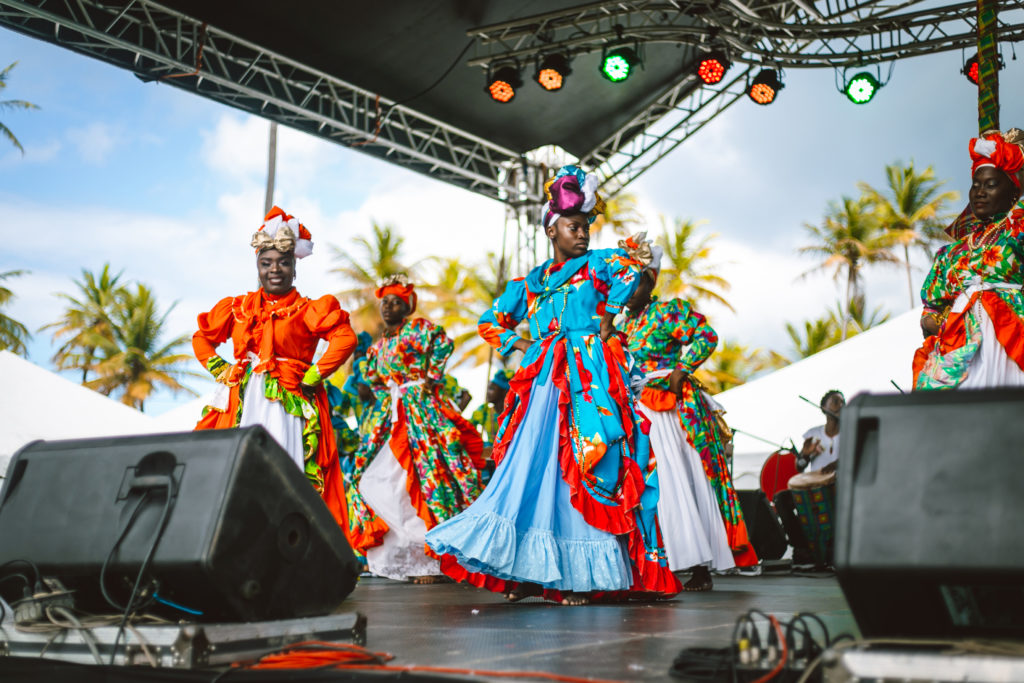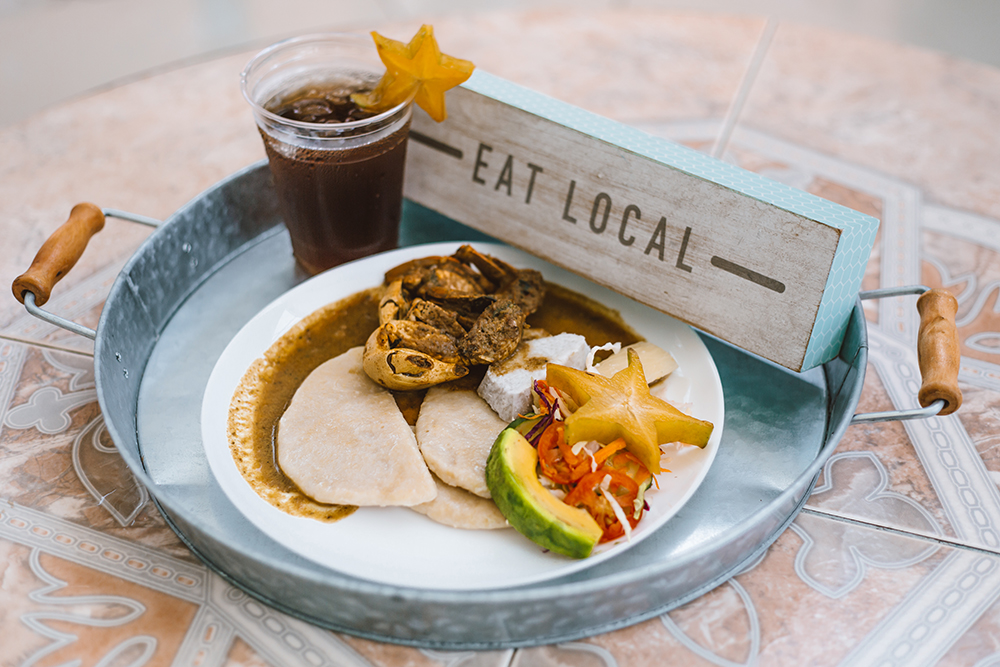
While it is the latter-mentioned landmass comprising the twin-island nation of Trinidad and Tobago, a visit to the smaller isle, which lies just short of 200 kilometres off the coast of Venezuela, proves Tobago stands on its own as an independent travel destination. Often referred to as the gem of the Caribbean, the idyllic and largely untouched island abounds with sandy beaches, a diverse tropical rainforest teeming with life, vibrant cuisine ripe with fresh ingredients from land and sea, and above all, a humbling authenticity and ease of being that solidifies a longing to return.
If it weren’t so pleasantly unpretentious, Tobago could easily boast of its ecological marvels—but its inhabitants let the land and seascapes speak for themselves. With numerous bays and inlets to choose from, driving along the winding coastline often leads to spontaneous ocean dips and beach hopping at some of the Caribbean’s most celebrated spots. One such destination is Pigeon Point, a renowned heritage park regarded as the island’s most beautiful beach, complete with a striking white-and-turquoise shoreline and a thatched-roof jetty for which the site has become known. Taking one of the many boat tours offered on Tobago allows visitors to see this lively hangout spot from an aquatic perspective, as well as an array of other natural wonders that are only accessible via water transportation.

Nylon Pool—a shallow in-sea swimming spot located just off of Pigeon Point—is well worth a visit. The pool-like oasis has pristine aquamarine water, which Princess Margaret likened to the sheerness of nylons upon naming it in 1962, and coarse ground coral sand perfect for exfoliating. Locals playfully suggest that a dip in the coralline sandbar can turn the clock back on one’s appearance due to its enchanted properties, but perhaps the serenity of the experience invokes a youthful energy shift from the inside out.
Not too far from the alleged fountain of youth lies Buccoo Reef. This protected marine park is ideal for snorkelers as schools of rainbow-hued parrotfish, vivid blue tang, and many others swim amongst the rhythmically swaying coral a short distance below. Larger reef inhabitants can be observed here too, such as slow-cruising barracudas and the majestic eagle ray. If you’re lucky, you might catch a pod of juvenile dolphins swimming together in unison alongside your boat, eventually heading into the horizon line, as these shallow waters are ideal for raising young.

South of the reef lies the mangrove wetlands of Bon Accord Lagoon—a nutrient-rich oasis which is home to one of the most significant fish nurseries on the island. The sea-grass sanctuary for small creatures like oysters and urchins is a sight to behold in daylight, but most magical during a nighttime excursion. Embarking in kayaks, the evening paddle offers visitors an intimate look at natural phenomena unique to the lagoon, including jumping fish and pelicans sleeping soundly in the mangrove trees above. The most spectacular scene comes from activating the lagoon’s bioluminescent algae, which emits an ethereal glow once triggered by motion. This can be done by swirling your oar or reaching your hand into the dark water below, but fully submerging in the warm shallow seawater is highly encouraged to enjoy the full effect of swimming in starlight.
While its ocean attractions are certainly exceptional, Tobago’s most distinctive experience rooted in nature is located on land. The island’s central Main Ridge mountain range surrounds the oldest protected rainforest in the western hemisphere (established as a reserve in 1764) and contains 22 endemic bird species. A hike with esteemed local guide William Trim ensures no sighting—no matter how camouflaged or fleeting—is missed. Having guided over a thousand tours, Trim’s passion for the rainforest is unmatched and his curiosity is contagious.
Only an hour spent in the humid, humming Forest Reserve yields a plethora of incredible sights. Brilliant birds are everywhere, including the Trinidad motmot, which possesses a striking blue head and a hypnotic pendulum swinging tail; the regal great black hawk perched stoically on a tree branch, unfazed by its audience; and an impressive array of hummingbirds, including the jewel toned white-tailed sabrewing.

The forest’s plant life is just as worthy of investigation. Some of the most eye-catching hues and shapes can be found in the protruding coral bulb of a ginger plant, the repeating spore patterns on the underside of giant ferns, and a wide variety of fungi—some of which, Trim excitedly explains, have yet to be classified. Emerging from the dense green thick of the tropical rainforest brings with it a newfound appreciation for the symbiotic existences between all of its flora and fauna.
Harmonious living is exhibited throughout Tobago, as the island’s infrastructure perfectly accompanies the surrounding environment. Pastel-hued homes with coordinating colourful cars in their driveways nestle into hillsides where goats and sheep graze freely. Trees with red, yellow, and pink blossoms line the curving roads amongst market stands displaying shells, jewellery, and fruit dangling whimsically on strings. The highly pigmented houses and buildings mirror the multicoloured backdrop of the natural landscape, but neither overpowers the other in a beautiful display of balance.

Tobago’s flavourful cuisine exemplifies harmony as well, being a dynamic fusion of African, Indian, Chinese, European, Latin American, and Middle Eastern influences. Food is a strong point of social connection on the island—Saturday is soup day, and this ritual means either cooking up a large pot at home or stopping at a roadside stand to pick up local favourites like callaloo or dasheen to enjoy. Roti, curry, fresh fruit, and thirst-quenching juices are all superb staples of Tobago, but the just-caught seafood and open-air ambience of its eateries hold no comparison.
Take the Seahorse, for example, located in Black Rock. The charming restaurant and four-room inn overlooking Stonehaven Bay is an undeniably romantic dinner destination, as patrons are enveloped in the soft glow of fairy lights set to the soundtrack of crashing waves. The blackened fillet of swordfish, seasoned with creole herbs and spices, is a standout.

Also in Black Rock is the Fish Pot, owned and operated by Irish couple Erica and Fiacra Vaughan, who moved to the island over a decade ago. The laid-back eatery has a changing board of specials and serves the catch of the day—varying from barracuda to red snapper—with a sauce of your choosing, including coconut curry and jerk. The restaurant sits overlooking an active but unobtrusive hub of nightlife and community. Soca music blasting from passing cars and animated chatter can be heard sporadically while enjoying a meal, but the sounds fit so seamlessly into the atmosphere that the restaurant’s resident hen rarely rouses from its slumber at the feet of diners.
A trip to Tobago wouldn’t be complete without trying its signature dish: curried crab and dumplings. Miss Trim’s stall at Store Bay Beach in Crown Point is the place to go for the island’s prized delicacy, and business has been booming for close to 40 years. The original Miss Trim has since passed the family-run operation down to her youngest daughter Meisha, who imbues the flavourful dish with the same care and expertise she learned from her mother. A notoriously messy meal, be prepared to have the curry sauce—made with local ingredients like Shadow Beni herbs—all over your face and hands by the time you’re through, and be sure to soak up the remaining sauce with the doughy flat dumplings.

The accommodations available on Tobago allow you to fully engage with the heart of the island. Take Castara Retreats—a cluster of sixteen open-air apartments integrated into the surrounding fishing village of Castara. Cool off in an outdoor shower, watch fishermen swim to their boats in the cerulean bay below, recentre with a yoga class, or set your sights on the comings and goings of the village from the hilltop vantage point. Better yet, descend into the lively hub to enjoy a Carib beer with locals accompanied by the sounds of live steelpan drumming.
There’s also Adventure EcoVillas in Plymouth, where guests are privy to countless wildlife sightings at their doorstep. The quaint accommodations are situated high in the treetops of a nature reserve, which feel particularly serene during one of the island’s short but significant rain showers. The Villas at Stonehaven, not far from the Fish Pot and the Seahorse in Black Rock, offer spacious guest houses that feel equally cozy with their dark wood and stone interiors and coral-hued walls. Equipped with amenities such as a plunge pool, a full kitchen, and ample rooms for friends and family, the feeling of being right at home is instantaneous.

Another secluded hideaway can be found at Mount Irvine Bay Resort in the island’s capital of Scarborough. Located on a former sugar and coconut plantation with some of the original structures still standing, the historic resort offers an 18-hole championship golf course and proximity to the finest surfing beach on the island. A short walk through the lush grounds to Mount Irvine Beach for a sunrise swim is the best way to start the day—the experience is both healing in its solitude and comforting by way of the friendly early morning swimmers around you.
Planning your trip around cultural events is a great way to deepen your experience with Tobago’s rich history. A visit on Easter Weekend means the opportunity to spectate the unusual and exciting sport of goat and crab racing in Buccoo Village, for which an impressive stadium has been erected to facilitate the festivities that began on the island in 1925. The Tobago Heritage Festival takes place from July 13 to August 1 every year and coincides with Emancipation Day, a holiday to commemorate the abolishment of slavery on Trinidad and Tobago in 1834. The festival closes with performers of all ages performing ancestral dances in traditional garments. Wearing smiles beaming with warmth and pride, this celebratory display of Tobago’s past and present showcases the authentic and endearing spirit of the island.

